Zoo Study Finds Animal DNA Floating in Air

FRIDAY, Jan. 7, 2022 (HealthDay News) – Take a whiff of the air in a zoo and you could breathe in the animals’ DNA – not just the smell of the food items they eat or their squander, a new review implies.
Sampling the air from community zoos, two teams of researchers gathered more than enough DNA to identify the animals close by. They say their review could likely develop into a useful, noninvasive software to observe biodiversity.
“Capturing airborne environmental DNA from vertebrates tends to make it probable for us to detect even animals that we are not able to see are there,” reported researcher Kristine Bohmann, head of the workforce at the University of Copenhagen in Denmark.
Even though terrestrial animals can be monitored by path cameras or examining for footprints or feces, a downside to these methods is they can involve intense fieldwork and involve the animal to be physically present.
This “environmental DNA,” or eDNA, is a very well-established method applied most routinely to keep track of aquatic organisms by sequencing eDNA from h2o samples.
“Compared to what people today discover in rivers and lakes, monitoring airborne DNA is genuinely, genuinely challenging, mainly because the DNA would seem tremendous diluted in the air,” reported Elizabeth Clare, guide researcher of the Queen Mary University of London workforce. “But our zoo research have nonetheless to fail for diverse samplers, genes, spots, and experimental methods. All of it labored and incredibly very well,” reported Clare, who is now at York University in Toronto.
The two teams revealed their “proof of thought” investigation Jan. six in the journal Existing Biology.
Just about every workforce carried out its particular person research at a community zoo, collecting samples in equally walled-in locations like the tropical household and indoor stables and outside, open-air enclosures.
To gather airborne eDNA, the Copenhagen workforce applied a enthusiast, like one particular applied to great down a laptop, and attached a filter to it. The enthusiast draws in air from the zoo and its surroundings. This could incorporate genetic material from breath, saliva, fur or feces, while the exact supply has not been decided.
After air filtration, they extracted the DNA from the filter and applied PCR amplification to make a good deal of copies of the animal DNA, the researchers reported. They processed the millions of DNA sequences and as opposed them to a DNA reference databases to identify the animal species.
The samples incorporate forensically very small amounts of DNA, Clare reported in a journal information release.
Clare’s workforce detected DNA from 25 species of mammals and birds from inside of the zoo and wildlife close by. Bohmann’s workforce detected forty nine non-human vertebrate species, which include mammal, fowl, reptile, amphibian and fish species.
It really is coincidence that researchers in two spots came up with the identical plan at the identical time, but soon after viewing each other’s content articles on a preprint server, the two teams made the decision to submit their manuscripts to the journal jointly.
“We made the decision we would alternatively acquire a little bit of a gamble and say we are not willing to contend on this,” reported Clare. “In fact, it can be such a outrageous plan, we are improved off acquiring independent confirmations that this performs. Both teams are quite eager to see this method establish.”
Additional info
The U.S. Office of Agriculture has more on wildlife investigation.
Supply: Mobile Press, information release, Jan. six, 2021
Cara Murez

Copyright © 2021 HealthDay. All legal rights reserved.
SLIDESHOW
When Animal (Allergies) Attack: Pet Allergy Indications, Cure
See Slideshow







:max_bytes(150000):strip_icc()/GettyImages-1308866465-5a0427599ef04870b9176456081e3bc3.jpg)